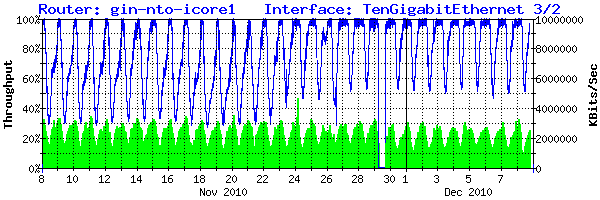 ©
©
At Comcrust, we're saying "fork queue" to "Network Neutrality"
New! Get Xfidgity now! (Comcrust's new same for the same old thing)
Date: Mon, 13 Dec 2010 21:07:34 -0800
From: Backdoor Santa <backdoorsanta1@hotmail.com>
Subject: Some truth about Comcast - WikiLeaks style
To: <nanog@nanog.org>
Ever
wonder what Comcast's connections to the Internet look like? In the
tradition of WikiLeaks, someone stumbled upon these graphs of their TATA
links. For reference, TATA is the only other IP transit provider to
Comcast after Level (3). Comcast is a customer of TATA and pays them to
provide them with access to the Internet.
1 day graphs:
Image #1:

Image #2:

Notice
how those graphs flat-line at the top? That's because they're
completely full for most of the day. If you were a Comcast customer
attempting to stream Netflix via this connection, the movie would be
completely unwatchable. This is how Comcast operates: They intentionally
run their IP transit links so full that Content Providers have no other
choice but to pay them (Comcast) for access. If you don't pay Comcast,
your bits wont make it to their destination. Though they wont openly say
that to anyone, the content providers who attempt to push bits towards
their customers know it. Comcast customers however have no idea that
they're being held hostage in order to extort money from content.
Another
thing to notice is the ratio of inbound versus outbound. Since Comcast
is primarily a broadband access network provider, they're going to have
millions of eyeballs (users) downloading content. Comcast claims that a
good network maintains a 1:1 with them, but that's simply not possible
unless you had Comcast and another broadband access network talking to
each other. In the attached graphs you can see the ratio is more along
the lines of 5:1, which Comcast was complaining about with Level (3).
The reality is that the ratio argument is bogus. Broadband access
networks are naturally pull-heavy and it's being used as an excuse to
call foul of Level (3) and other content heavy networks. But this
shoulnd't surprise anyone, the ratio argument has been used for over a
decade by many of the large telephone companies as an excuse to deny
peering requests. Guess where most of Comcasts senior network executive
people came from? Sprint and AT&T. Welcome to the new monopoly of
the 21st century.
If you think the above graph is just a bad day or maybe a one off? Let us look at a 30 day graph...
Image #3:

Comcast needs to be truthful with its customers, regulators and the public in
general. The Level (3) incident only highlights the fact that Comcast is
pinching content and backbone providers to force them to pay for
uncongested access to Comcast customers. Otherwise, there's no way to
send traffic to Comcast customers via the other paths on the Internet
without hitting congested links.
Remember that this is not TATA's
fault, Comcast is a CUSTOMER of TATA. TATA cannot force Comcast to
upgrade its links, Comcast elects to simply not purchase enough capacity
and lets them run full. When Comcast demanded that Level (3) pay them,
the only choice Level (3) had was to give in or have its traffic (such
as Netflix) routed via the congested TATA links. If Level (3) didn't
agree to pay, that means Netflix and large portions of the Internet to
browse would be simply unusable for the majority of the day for Comcast
subscribers.
Love,
Backdoor Santa
 ©
©


